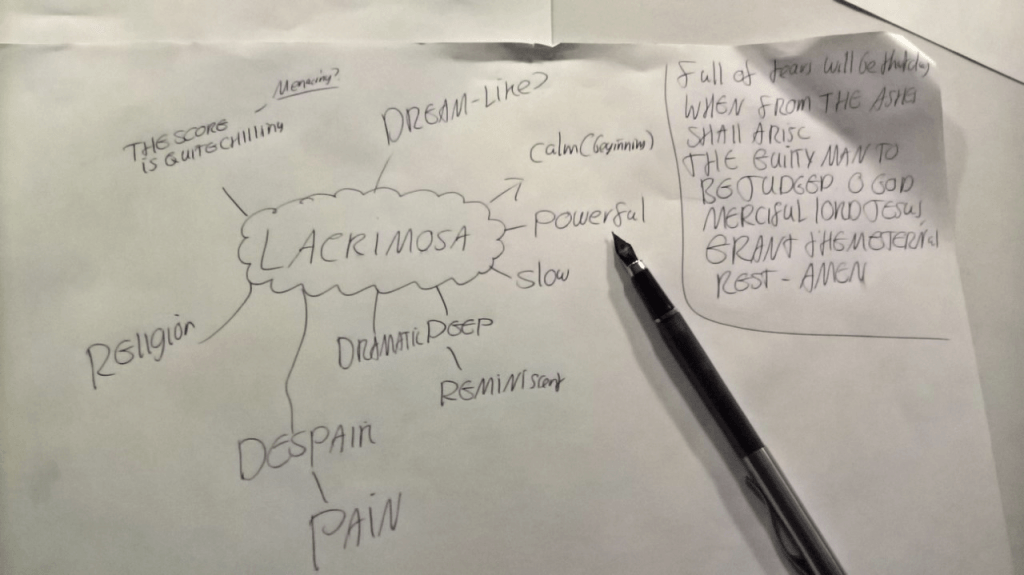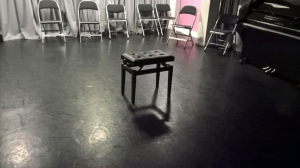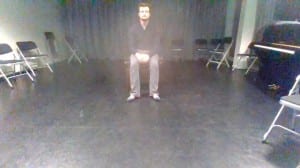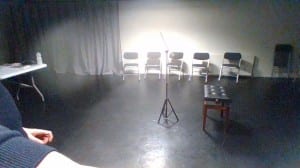I began to start messing around in the studio over the last couple of days from Friday – Sunday.
It dawned on me as to how difficult it is to generate material for a solo show when it is just you in the room with nothing or nobody to bounce off.
Over the course of this time, I played around and started to write random thoughts and feelings that came to me. These included thoughts about the type of show I was going to create, text, and music.
I still have no idea what my show is going to be about, this post is just a collection of things that I found and thought about over the course of the past few days. I thought a lot about the use of music in the show and how music can work theatrically. On Friday, I listened to Mozart’s Requiem in D Minor K:626. One of the notable sections of the epic score was Lacrimosa.
Lacrimosa is one of my favourite pieces of classical music. I listened to it multiple times whilst mind-mapping how it made me feel and the type of atmospheres and themes it conveyed.
From the mind-map I noted down the dream-like feel of the music. Particularly the sections which are more calmer and slower in places. Lacrimosa is an orchestral piece that has a substantial amount of crescendos throughout the score which only lasts 3 minutes 20 seconds. The crescendos give a dramatic and despairing sense and possibly suggests pain and reminiscence, as written above. As I was listening to the music I noted down it’s obvious religious connotations. Lacrimosa is latin for weeping, and is derived from Our Lady of Sorrows, a title given to Mary, mother of Jesus. It also has a relation to Astrology in which an asteroid was named 208 Lacrimosa.
History of Requiem
Requiem in D Minor was the last thing Mozart composed in Vienna 1791 and was left was unfinished due to his death on 5th December the same year.
Franz Xaver Sussmayr finished the composition in 1792 and was then delivered to Count Franz von Walsegg, who has anonymously commissioned the piece for a Requiem Mass to commemorate the anniversary of his wife’s death.
At the time of Mozart’s death on 5 December 1791, only the first two movements Requiem Aeternam and Kyrie were completed in all of the orchestral and vocal parts. Lacrimosa was the final section that was completed in full and was not in ‘skeleton’ form.
The completed score, initially by Mozart by largely finished by Sussmayr, was then dispatched to Count Walsegg along with a counterfeited signature of Mozart.
Constanze (Mozart’s wife) had to keep the secret that Requiem was unfinished at the time of her husband’s death. Mozart only received half the commission in advance, so after his death, Constanze wanted to have the work completed in secret by somebody else.
Constanze orchestrated half-truths and myths post Mozart’s death. She suggested that her husband was composing the Requiem for himself, and that he had been poisoned.
Despite being incredibly ill at the time of composing this, his continued to work. Even on his last day of his life, he worked on the piece.
I found looking at the history of the piece very intriguing. Especially in relation to Mozart’s life. The history and connotations of Lacrimosa during my research also proved really interesting except when in the studio, I had no idea of how to create / generate material out of this. As I was listening to this, as well as beginning of Requiem in D Minor I began to write some text.
Below are the three texts that I wrote. All very haphazard and all written in the moment of listening to the music.
TEXT 1
I tread freely like a man with no limits
I move like one of those old sacred spirts
And coo-coo, coo-coo my wisdom away
This day, I say will mark a true enlightenment.
I wonder and wish upon a star
That, that dainty divine will close up shop
And me at the top
Will plop and top and drop the border
The order
The motar to build.
Truly life has never been so good
Truly I say to the comitee
The hood
Why has life always been this good
In the hood
In the hood
In the hood
Why has life always been this good
Privaledge.
TEXT 2
Seizing the day has never felt so good
except the being the would
stand trial for all crimes against
the constitution
the written and forgotten text
We cannot wait to seize the day
that way back when
things were good hopeful. Cheery then.
Back before old blondie took power
Like plucking the flower from the land of freedom
and crushing in his palm.
we cannot remain calm
We cannot sid Idly and watch from the sidelines
we cannot sit idly and watch from the skies
Time flies
yet, nothing happens.
Truly, nothing happens
what we see, what we do, has no effect on you
and yet when we stand we make a difference.
A difference.
TEXT 3
We are here as one
we are part of the puppet motel
we shall not tell
those lies uttered first by them
in their crime
this time we act as one body
said nobdy. Ever.
Too strong are we to determine
the growing cause of hell-oneart
cold wreched hearts birth
an uncontrolled desire to rule.
We’re going down to the bottom
the very bottom. Frefalling to the bottom
Drowned, in aspirations are we
That is so very clear to see
All three, looking back are all overtly political in some way. I think that’s how I write and that’s how I want my show to be like. I don’t want to make a show that features preachy politics, or a rant about how rubbish the world is at the moment, because I think we, as morally conscious and decent individuals already know that the world is failing. Yet, I am always of the opinion that art and theatre always reflects the world in one way or another. I want the show to be inspired by current events, but not led by them. One of the writing exercises that I did to generate material two weeks ago in one of the workshops reflects a kind of parody rather than a preachy portrayal of Donald Trump.
VOICEOVER. January 20th 2017 was the day the Earth stood still and gasped in horror
A man dressed in a suit with a Donald Trump mask enters the space from the doors first used by the audience. He addresses the audience
MAN. Hi. So, umm welcome. I think I expected more of you to be honest. But I guess this will have to do so. Imagine this chair is a throne. And I am sat on this throne and there is a big portrait of me on the back of a grizzly bear is positioned behind it. Okay?
let’s not forget to imagine that there are significantly more of you. Imagine there’s a wall seperating me from you and you from me. But you can still see me and I can see you but you are not invading my own personal space. Imagine there’s a rally outside. Someone shouting and screaming they’re wailing, complaining about me. They should’ve voted for Hilary he says. They should’ve put that woman in charge and now imagine that he, this man is being dragged away, ever so slowly back behind the seats, past and out of the space down the stairs out into the air and shot.
God Bless America
The man removes the mask and looks at the audience as if he was just seen them for the first time
Text three in particular was very interesting when reflecting and writing. I had made a reference to ‘puppet motel’ a song by Laurie Anderson. This led me to thinking about the style of the performance. I want to experiment with it and push the boundaries of my own comfort zone. An example of this would be on Saturday’s rehearsal in which I played around with ways of delivering the text. As I am interested in the associations of music and the aestheticism of it visually I began to think about what kind of objects I could use on stage, as seats, as props, as set.
I found the idea of having a single piano stool in a space interesting. I don’t know exactly why. I thought about what the stool, aesthetically, is associated with being partnered with a piano and by putting this object in the space and using it as a theatrical prop seemed interesting to me.
When started playing with the way to deliver the text, I started to compose something quite basic and rough alongside it. My intention was not to sing the words because singing is not my strong suit, but I wanted to reflect a style of textual delivery in which the music helps dramatasise and life the reading of the text, rather than the singing of it. This is similar to some songs by the musicians Tim Minchin and Laurie Anderson.
Laurie Anderson’s music in a nutshell is very surreal, very electronic and is an influence on me. There is the argument that she has pioneered a new avant-garde in electronic and synthesised music. The use of synths and distorted voices in her creates a archaic worlds and atmospheres. Alongside Laurie Anderson being an influence towards very archaic themes. David Lynch’s work, films and notably music really portrays this effectively. When I was listening to both her and Lynch I came to the conclusion that I wanted to show to become very experimental and bizarre. I don’t necessarily seek audience approval. I’d like to create a show that challenges expectations. This is how I see Laurie Anderson’s work along with David Lynch. They go beyond the reaches of their mediums and in regards to theatre the artist that I closely associate with this way of working is Tim Crouch. Notably An Oak Tree and The Author
Bibliography




